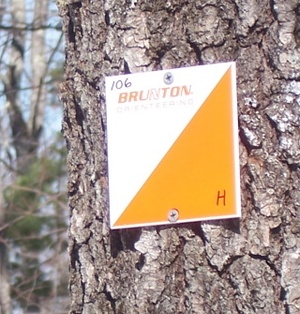… and yourself!

Knowing how to orient a map is an orienteer’s most valuable skill. What you are doing is positioning the map relative to your surroundings. There are 2 ways to do this – using landmarks or using a compass.
Landmarks
Simply look for distinguishable landmarks that are marked on the map, and turn so that both you and the map are facing this object. Turn the map so that the map is showing that landmark in front of your position. If you do not know your position, you may need to use several landmarks to locate your location. Unfortunately, when in the wild there are few landmarks. At Libby Hill we have posted trail maps with “You Are Here” pointers, but you’ll note that these maps are always positioned with the words facing up for easy reading. They do not show which direction you may be facing, or which way to walk along the trail to get to your desired destination. To get the map pointing the correct way (to match the landscape), you can use a compass.
Compass
This is a simple process that most people can easily master.
- Turn the ring on the compass so that the “N” on the ring lines up with the Direction of Travel Arrow.
- Place your compass on the map so the long edge is aligned with the North Arrow on the map, which points to magnetic north (not true north). (See What is Declination? below);
- Holding the map AND compass perfectly level, turn the map and compass together until the RED end of the floating needle is inside the red arrow outline on the compass baseplate. Your compass now points to magnetic north, and the map is correctly aligned with the landscape. In other words, a trail to your right on the map is also on your right in the landscape.
What is Declination?
Declination is the measurement in degrees of the angle between true north and magnetic north. The beginner only needs to recognize that there IS a difference, and know if your map shows magnetic north or true north. Orienteering maps show magnetic north, so you can use your compass without any adjustments. Declination varies from one location to the next and actually changes from year to year for any given area. If you’re navigating a significant distance by compass, or you have a map that’s a few years old, you might want to check the actual declination for the area before heading out. On our maps, “north” is adjusted to 16° 5′ W (for zip code 04039 in Feb 2008). Some orienteering maps also have equally spaced black lines oriented to magnetic north to aid in compass navigation. Our geographic area is small enough that we opted for a simpler map and chose not to include these lines.
